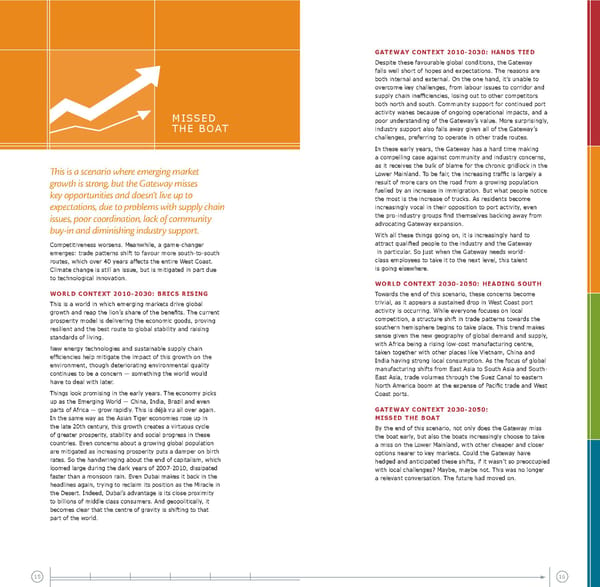gAteWAy context 2010-2030: hAnds tied despite these favourable global conditions, the gateway falls well short of hopes and expectations. the reasons are both internal and external. on the one hand, it’s unable to overcome key challenges, from labour issues to corridor and supply chain inefficiencies, losing out to other competitors both north and south. community support for continued port Missed activity wanes because of ongoing operational impacts, and a poor understanding of the gateway’s value. More surprisingly, the boat industry support also falls away given all of the gateway’s challenges, preferring to operate in other trade routes. in these early years, the gateway has a hard time making a compelling case against community and industry concerns, as it receives the bulk of blame for the chronic gridlock in the This is a scenario where emerging market Lower Mainland. To be fair, the increasing traffic is largely a growth is strong, but the Gateway misses result of more cars on the road from a growing population key opportunities and doesn’t live up to fuelled by an increase in immigration. but what people notice the most is the increase of trucks. as residents become expectations, due to problems with supply chain increasingly vocal in their opposition to port activity, even issues, poor coordination, lack of community the pro-industry groups find themselves backing away from advocating gateway expansion. buy-in and diminishing industry support. With all these things going on, it is increasingly hard to competitiveness worsens. Meanwhile, a game-changer attract qualified people to the industry and the Gateway emerges: trade patterns shift to favour more south-to-south in particular. so just when the gateway needs world- routes, which over 40 years affects the entire West coast. class employees to take it to the next level, this talent climate change is still an issue, but is mitigated in part due is going elsewhere. to technological innovation. World context 2030-2050: heAding south World context 2010-2030: Brics rising towards the end of this scenario, these concerns become this is a world in which emerging markets drive global trivial, as it appears a sustained drop in West coast port activity is occurring. While everyone focuses on local growth and reap the lion’s share of the benefits. The current prosperity model is delivering the economic goods, proving competition, a structure shift in trade patterns towards the resilient and the best route to global stability and raising southern hemisphere begins to take place. this trend makes standards of living. sense given the new geography of global demand and supply, new energy technologies and sustainable supply chain with africa being a rising low-cost manufacturing centre, taken together with other places like Vietnam, china and efficiencies help mitigate the impact of this growth on the india having strong local consumption. as the focus of global environment, though deteriorating environmental quality manufacturing shifts from east asia to south asia and south- continues to be a concern — something the world would east asia, trade volumes through the suez canal to eastern have to deal with later. North America boom at the expense of Pacific trade and West things look promising in the early years. the economy picks coast ports. up as the emerging World — china, india, brazil and even parts of africa — grow rapidly. this is déjà vu all over again. gAteWAy context 2030-2050: in the same way as the asian tiger economies rose up in missed the BoAt the late 20th century, this growth creates a virtuous cycle by the end of this scenario, not only does the gateway miss of greater prosperity, stability and social progress in these the boat early, but also the boats increasingly choose to take countries. even concerns about a growing global population a miss on the lower Mainland, with other cheaper and closer are mitigated as increasing prosperity puts a damper on birth options nearer to key markets. could the gateway have rates. so the handwringing about the end of capitalism, which hedged and anticipated these shifts, if it wasn’t so preoccupied loomed large during the dark years of 2007-2010, dissipated with local challenges? Maybe, maybe not. this was no longer faster than a monsoon rain. even dubai makes it back in the a relevant conversation. the future had moved on. headlines again, trying to reclaim its position as the Miracle in the desert. indeed, dubai’s advantage is its close proximity to billions of middle class consumers. and geopolitically, it becomes clear that the centre of gravity is shifting to that part of the world. 15 16
 Monitor Deloitte - Final Report Page 65 Page 67
Monitor Deloitte - Final Report Page 65 Page 67